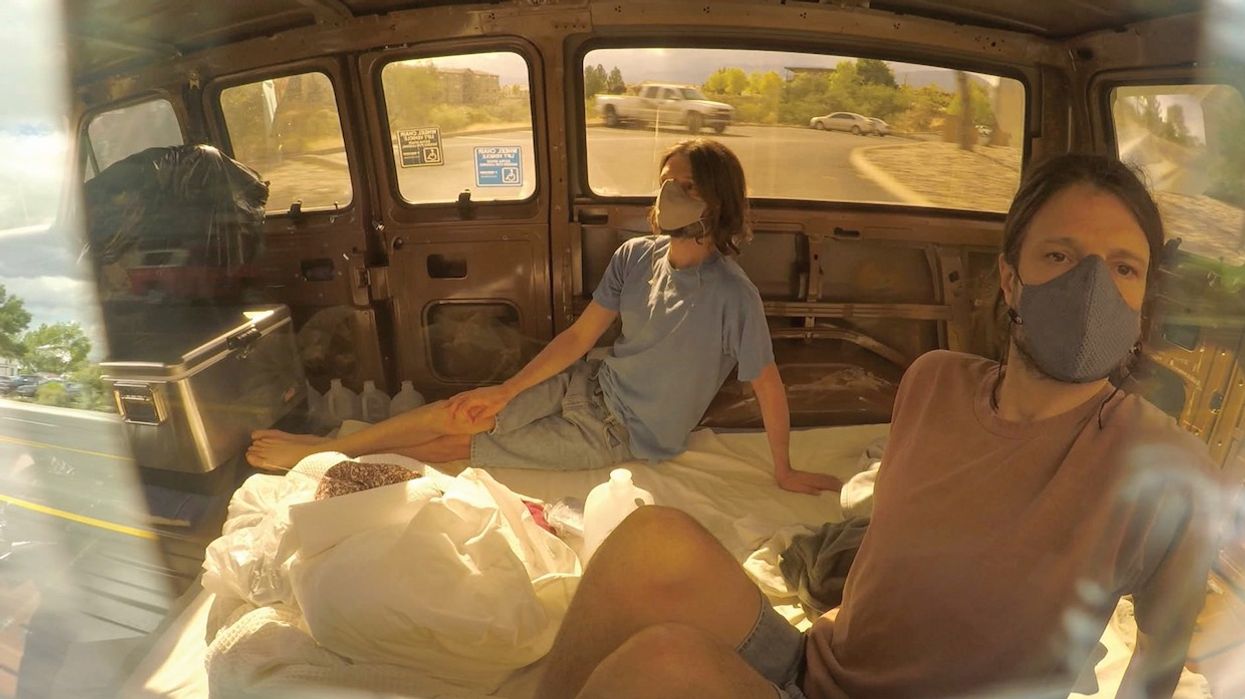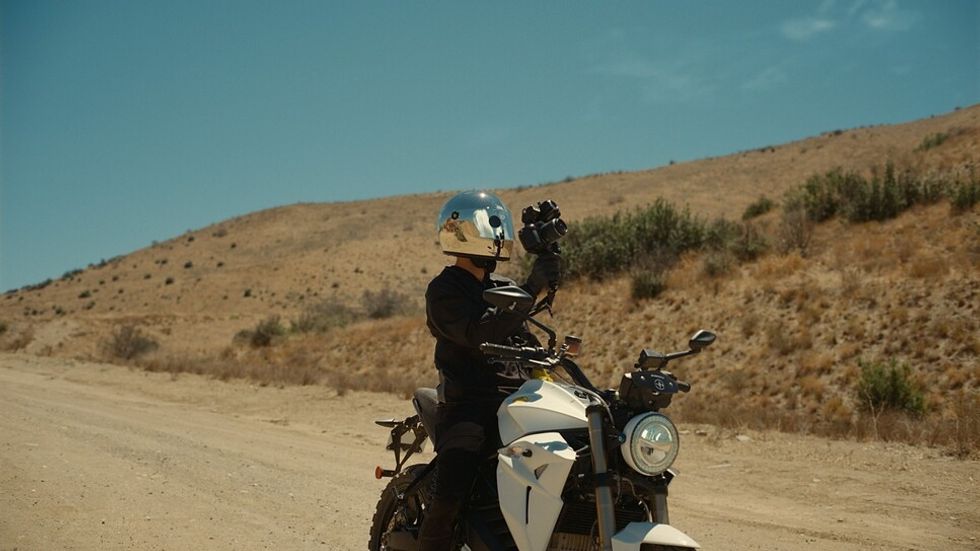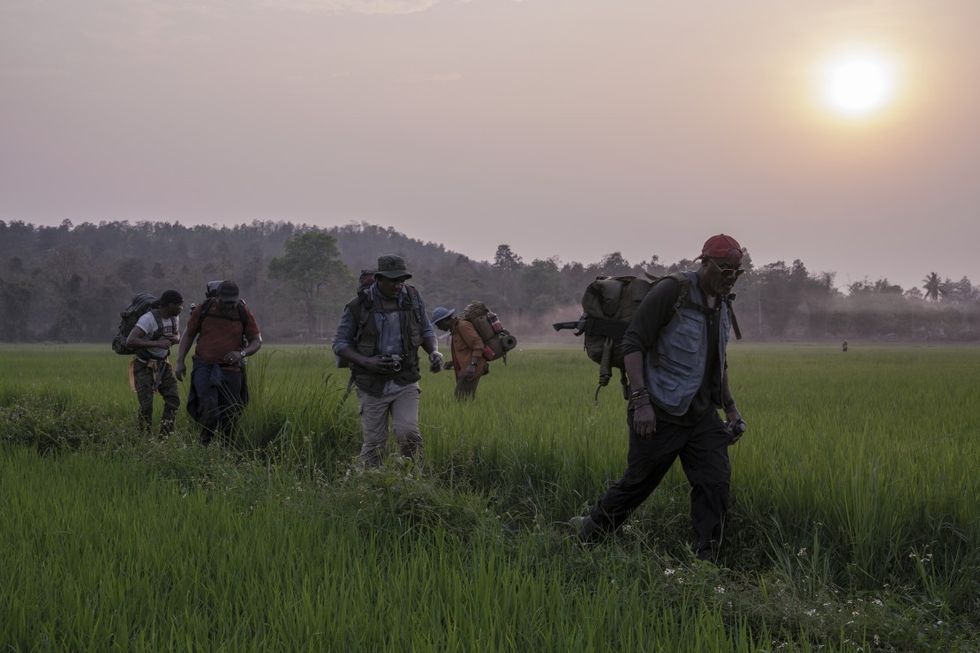'The Sensitives': Drew Xanthopoulos on Why Reading Body Language is Essential to Being a DP
Drew Xanthopoulos' 'The Sensitives' tells the story of a disease that no one understands.

"When we are no longer able to change a situation, we are challenged to change ourselves," Viktor Frankl famously wrote from a concentration camp in World War II. But what if, for some people, it's the other way around?
That's the case for the subjects of Drew Xanthopoulos' documentary The Sensitives, which recently premiered at the Tribeca Film Festival. The film follows victims of Multiple Chemical Sensitivity Disorder (MCS), a mysterious syndrome that is thought to be caused by environmental factors, such as pollutants and chemicals, causing a wide range of debilitating symptoms, such as headaches, extreme fatigue, nausea, and paralyzing joint pain. Because MCS is not recognized by the American Medical Association and there is no consensus on diagnostic terms, sufferers are left to their own devices, often seeking relief in remote desert communities where their symptoms are not aggravated by cell phones, electric appliances, or other elements of modern society.
As both cinematographer and director, Xanthopoulos trains an intimate eye on a small group of so-called sensitives, some of whom are forced to live in the dark, others in a sterilized home they haven't left for years, and still others who have uprooted their lives in order to live a simple, isolated existence in a desert community. Spending nearly three years filming his subjects, Xanthopoulos captures their physical and emotional pain as they struggle to navigate a life utterly transformed by a disability that no one—including themselves—understands.
No Film School caught up with Xanthopoulos and producer David Hartstein at Tribeca to discuss Xanthopoulos' intimate access to this untold story, his decision to shoot on $200 vintage Japanese lenses, and why sometimes having too many resources to make your film can be a bad thing.
"I had to shoot on long lenses for this film because I couldn't get really close to the subjects [due to the illness]."
No Film School: How did you find this incredible story?
Drew Xanthopoulos: I saw a photo in the New York Times about five years ago by Thilde Jensen, who took photos of people around the country who were fleeing their homes and going to the desert to try and find some relief from their illness. Her photos haunted me for months. I couldn't get them out of my head. Eventually, I called her and she was kind enough to start inviting me on her shoots to see for myself. She ended up introducing me to many of the subjects that ended up in the documentary. She, herself, was very sick, but now she's much better. So for her to vouch for me and introduce me to people was a huge "in" to the community that otherwise would be hard to gain access to.
Xanthopoulos: I met a lot of people. It was a year and a half of scouting and casting all around the country. I filmed with a lot of people and ended up settling on the three groups in the movie because there was something about them that I could relate to. It wasn't about the illness; it was about their lives beyond the illness. It was critical to be able to just have normal conversations with them and get to know them as people beyond the illness. I ended up choosing the subjects I chose because they had held on to a part of their humanity that was universal and relatable to an audience.
I think with every great film that you see, you're watching characters that the director relates to on some level. It doesn't matter if they're good or bad. Relating is how we can tell those stories.
NFS: Did you do a lot of research into Multiple Chemical Sensitivity (MCS)?
Xanthopoulos: Yeah, I read a lot of research papers. There's not a lot out there compared to more mainstream illnesses, where there's a lot of literature you can read about them. That's one of the things I really hope that this film can contribute to: inspiring more research on the topic. It badly needs it. There are no agreed-upon treatments for this condition. These people are left to their own trial and error to figure out what's bothering them and what helps them feel better. So that's incredibly difficult.
"We drown in too many resources. I think as artists, we are at our best with parameters."
Mostly, I was interested in what it was like to live like this and how it transforms people's lives. I mean, everyone in the film, at one point, was just like you and I. They have families. They have kids. They have grandkids. They had spouses. They had jobs. They lived in cities. They were us, and this thing transformed them into being different people. You know, a lot of people with this illness change their name because they don't identify with who they once were.
NFS: That is incredibly sad.
Xanthopoulos: It really is.
NFS: After you decided you were going to embark on the film and had found your subjects, how did the rest come together?
Xanthopoulos: A lot of patience. I filmed the current state of their lives for about two years. It was just their routines, like how they made [life] work where they were living. I didn't know for a long time if anything was going to change in their lives. I checked in with them constantly and went to film with them pretty much every month for a week or longer. It was just a lot of being patient and being present in their lives as much as possible.

NFS: At first, you were a one-man-band, but later on in the process, you assembled a dedicated crew. How did you find each other?
Xanthopoulos: David [Hartstein, producer] came on really early on in the process. I had been working on really early research and test footage for maybe a year. I remember I invited David over to my apartment after we did a shoot together. I wanted to sit down and talk to you about this project. I think that was the first time I showed you any footage.
David Hartstein: It was. But even when you first told me about it, it sounded as amazing as it is onscreen now. I was just like, "Why don't you talk about this more?"
"There are pros and cons to having to operate and direct at the same time."
Xanthopoulos: He scolded me that I wasn't talking about it enough. So when I showed David footage, he said, "I think I need to help with this. Like, as producer." I was expecting him to be like, "Oh, well you know, there's a student that might be interested in helping you. Whatever." Because I had no money. I didn't know what I needed.
Hartstein: It was about knowing how incredible [Drew] is. For me, it's the subject matter, but it's also the collaborator.
Xanthopoulos: Then, Andrea [Meditch, executive producer], I met at a pitch at the Camden International Film Festival. That was the first public stage this film was presented in. I won the pitch. Andrea was on the panel as one of the judges. After I'd won the award, she pulled me aside and said, "Drew, let's talk about this—how I can help you with this film?" Then, for an editor, we searched far and wide and talked with a lot of people. They were all brilliant, but what it came down to was David [Fabelo's] heart. It won us over. He's got the biggest heart. Such an incredible capacity for empathy. This is not an easy subject to sit with for nine months. David had the stamina to be able to see some of the hardest footage that I shot and to still have energy to be empathetic and find levity.
NFS: Did the fact that you had two years of footage to show help you secure the rest of the financing and support that you needed to finish filming?
Xanthopoulos: People were really compelled by the footage. I think they saw the intimacy and the access and, I think, the beauty of what I was trying to show in the film. I've been fortunate to always compelling footage, even early on. That very much helped. It helped us with grants, definitely.

NFS: Some documentarians are shy about covering intimate conversations, such as the one the husband and wife are having about their marriage in your film. That was probably the most difficult conversation those two people have ever had, and you're right there with a camera. How do you navigate?
Xanthopoulos: I don't think I could have filmed that scene had I not already been filming them for about two years. So I had their trust. They knew I was rooting for both them. In terms of that conversation...We had a test screening and somebody who's from Kansas or Missouri saw that and said, "They weren't talking for two minutes, but they were communicating the entire time. It's called Midwestern Fight."
I think it's all about reading body language and trying to anticipate [movement]. I knew them so well and their body language so well. Being able to read body language is a huge part of being a cinematographer. It's tremendous. Even on fiction stuff that I shoot. It helps so much when I can work with certain actors before. They know my cues and I know their cues. It's a sort of dance that becomes very organic. We're speaking fluently to each other.
NFS: Did you shoot everything vérité? Did you ever jump in and ask questions?
Xanthopoulos: It was all vérité. There were mornings when Joe was out walking on his walks and Lannie was home alone, so I asked questions that would kind of be some of the foundation of the voiceover you hear in the documentary. But for the most part, it was vérité. It was just me witnessing their lives and how they unfolded.
NFS: I imagine that having to direct and shoot at the same time makes accessing intimacy easier. You don't have to break your crew character; you can kind of stay behind this wall.
Xanthopoulos: I think so. It's the oldest tradition of documentary filmmaking. Think of Les Blank or Albert Maysles. They held a camera. Your direction comes in trying to anticipate where things are going to be going. I think a director for fiction films does the same thing. You're trying to anticipate how it's really unfolding in front of you now that you have the script in your back pocket. You've thought about this movie, but now it's happening organically with real people playing these characters and real places. You might have had a sunny day written into the script and it's raining now. You have to have that sense of anticipation and just roll with the punches.
"It's ironic to me that we're spending a lot of money making lenses look like they used to a long time ago."
Documentary [requires] the highest form of anticipation. There is no script in your back pocket. You kind of have expectations of how things are going to go, but you never know. So there are pros and cons to having to operate and direct at the same time. On a traditional documentary shoot, the director is not also shooting; they have eyes on everything that's happening. As a shooter, I have to keep an eye on my periphery and maintain the frame at the same time. Of course, if I only had to shoot, the film might be a little bit prettier, and I may have seen more perspectives on what was happening. But I learned to tap my head and rub my belly at the same time pretty quickly.
NFS: One-man-banding also affords you this laser perspective where your world is encompassed in the frame.
Xanthopoulos: For sure. For this kind of film, it worked perfectly. It's people in complete isolation—usually one or two characters at a time. So to have that laser focus with a camera worked fine. But often times, when I would take breaks from shooting, what I would try to go over in my head is, What was happening all around me? What was happening off camera that entire time? Because as a director, that's what you need to be aware of. Not just the main subjects, but everything around them that's informing what they're doing and how they're reacting to things. As a camera person, you can miss those things sometimes.

NFS: What did you shoot on?
Xanthopoulos: None of the cameras I shot on are sexy. I don't know if the cameras are the most interesting part about how the movie looks. I think the lenses were. I had to shoot on long lenses for this film because I couldn't get really close to the subjects [due to the illness]. So, on Ebay, I bought these really old, cheap Japanese Tokina zoom lenses for $200. I shot 99% of the film with a 28-90 or a 28-80 F4 lens that nobody would ever want to buy today. I bought it because A) I didn't have a lot of money to buy an expensive lens at the time, and B) digital sensors are a very clean palette to the point where it's difficult for them to capture the organic quality of life. To me, the glass translates that quality quite a bit. These lenses were old and had character to them. They picked up light a certain way, made skin look a certain way, made the air look a certain way. They had a texture to them. So I was attracted to that.
"Being able to read body language is a huge part of being a cinematographer."
I don't think the flashiest, most expensive stuff is always the best for a project. Nowadays, you can pay tens of thousands of dollars on a set of Cooke primes where they've actually gone out of their way to remove the coatings that make them look older. It's ironic to me that we're spending a lot of money making lenses look like they used to a long time ago.
NFS: You found this untold story, wanted to capture it, and just kind of went out and started doing it. Do you have any advice for people who stumble across a story or find themselves embedded in a world that they want to film, but don't have the infrastructure to start production?
Xanthopoulos: Vérité in itself is humbling. An interview-based documentary is easier to do, but you need more resources to do it. You have to rent lights, spaces. I was a one-man-band out there. It's fortunate that I'm also a cinematographer, so I owned everything that I needed to shoot. And my freelancing schedule allowed me to self-fund the first few years of shooting. I'd go shoot a commercial and then I'd go shoot in the field for two weeks. Then, I'd come back and shoot something for hire.
I'm tempted to sort of paraphrase the old Werner Herzog advice: "Steal, break in. Do whatever you need to do to make your film." If it's something you're in love with and you can't stop thinking about, you'll figure out a way to make it work.
Great art is made around great parameters. If I was given all the resources in the world—or even $2 million—to make this documentary, I don't think it'd be better. We drown in too many resources. I think, as artists, we are at our best with parameters. So I'd say for a young filmmaker, or an old filmmaker, just try to make it work with a lot of parameters. Embrace them; they will make your art unique. This is what creates your fingerprint. Parameters are critical for creativity. Because that's life. If you have nothing, find something and you'll make great art.
For more, see our complete coverage of the 2017 Tribeca Film Festival.






















